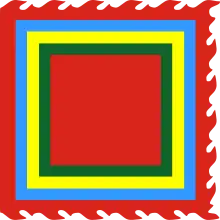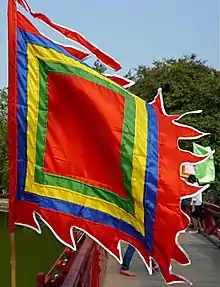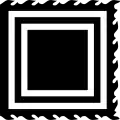Vietnamese five-color flags
In Vietnamese culture, five-color flags (Vietnamese: cờ ngũ sắc, Chữ Hán: 旗五色) or five elements flags (Vietnamese: cờ ngũ hành, Chữ Hán: 旗五行), deity flag (Vietnamese: cờ thần, Chữ Hán: 旗神) are traditionally flown during festivals and religious ceremonies. A five-color flag consists of five concentric squares in red, green, yellow, and blue, representing the five elements (ngũ hành). The order of colors varies. The outermost square has three ragged edges, similar to fringing. The center of the flag is sometimes defaced to commemorate a specific concept or personality.
 | |
| Use | Other |
|---|---|
| Proportion | 1:1 |
| Vietnamese five-color flags | |
| Vietnamese alphabet | Cờ ngũ sắc |
|---|---|
| Chữ Hán | 旗五色 |
.png.webp)

A five-color flag at a festival in 2010 commemorates the millennial of the founding of Thăng Long (Hanoi).
Historically, some imperial and military ensigns followed a similar pattern.
Variations
 Imperial ensign of the Nguyễn dynasty (1802–1955)
Imperial ensign of the Nguyễn dynasty (1802–1955) Flag of Thánh Trần (1956–1975) used by the Republic of Vietnam Navy
Flag of Thánh Trần (1956–1975) used by the Republic of Vietnam Navy Funeral flag
Funeral flag.svg.png.webp) Catholic funeral flag
Catholic funeral flag.svg.png.webp) Catholic funeral flag (Good Friday variant)
Catholic funeral flag (Good Friday variant)
See also
External links
This article is issued from Wikipedia. The text is licensed under Creative Commons - Attribution - Sharealike. Additional terms may apply for the media files.